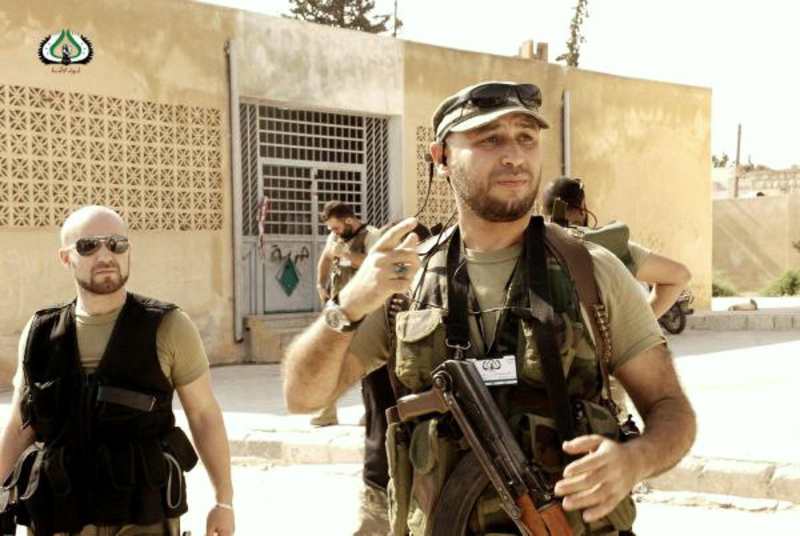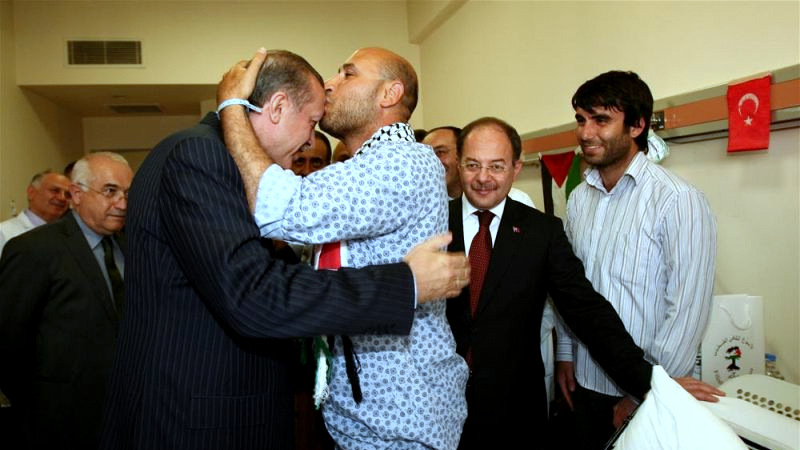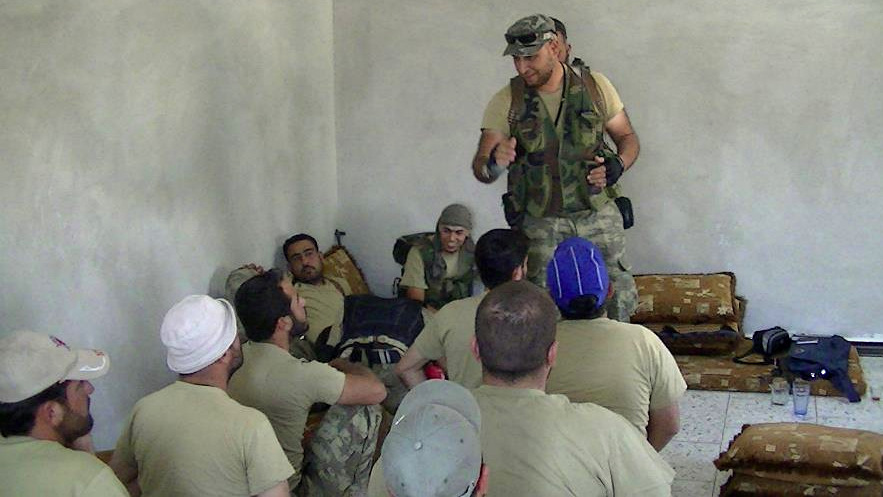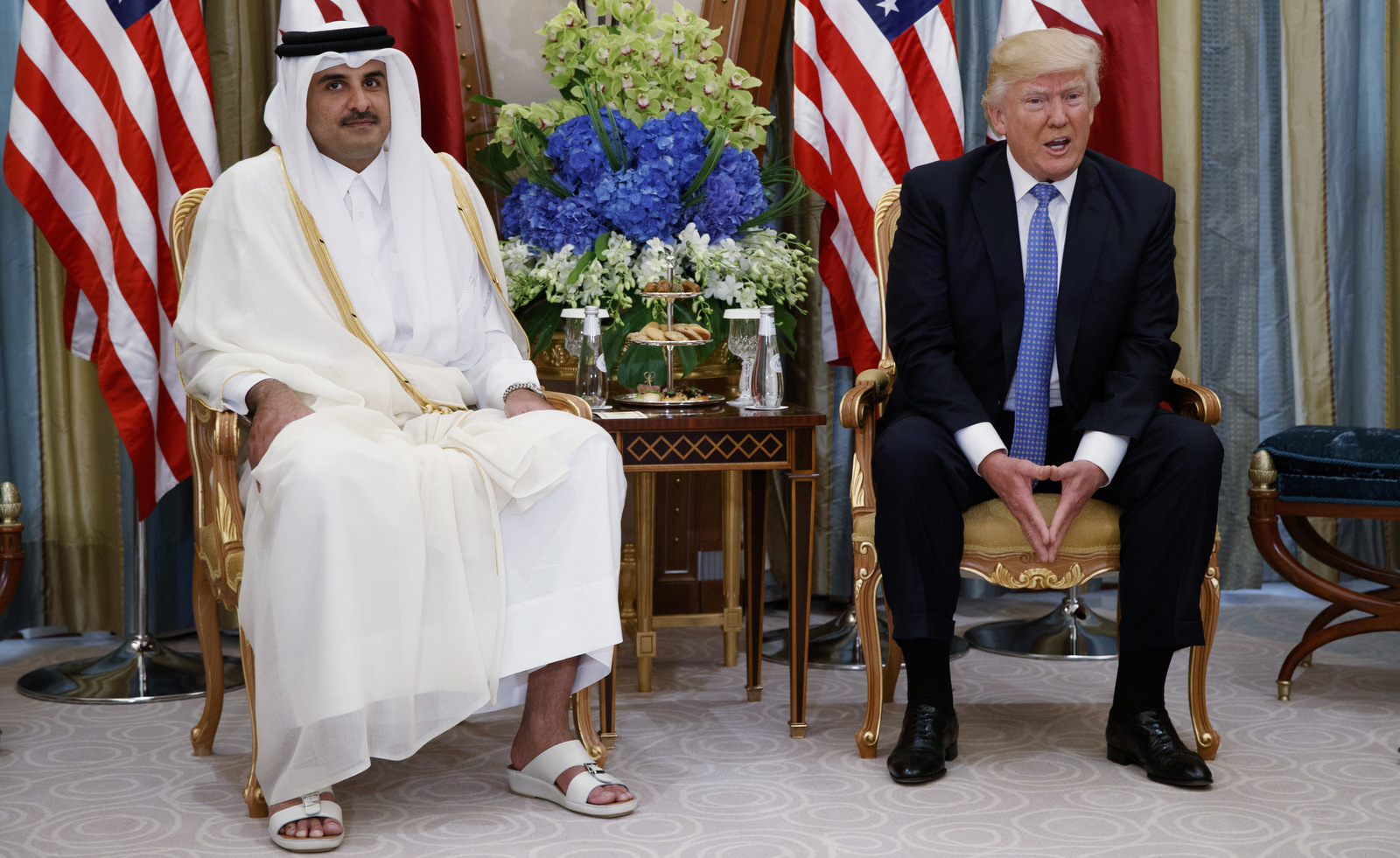
Mahdi al-Harati, former commander of the Tripoli Brigade during the Libyan Civil War, is seen here fighting in Syria as commander of Liwaa Al-Umma, a designated terrorist group fighting the Syrian government.
BEIRUT (Analysis) –– Interpol may be on the hunt for the former mayor of Libya’s capital of Tripoli – an Irish-Libyan man who has been named as an international terrorist by Saudi Arabia.
Mahdi al-Harati has lived in Malta on-and-off since 2014. In January 2017, he was arrested due to his involvement in a knife attack in Malta that occurred between two Libyans, as all three had gotten into a political argument that grew out of control.
It is odd that al-Harati would seek safe harbor in Malta, which is a small island in the Mediterranean Sea. However, it is this very sea in which al-Harati first sailed into the international spotlight due to his associations with al-Qaeda and other terror groups. His relatively recent arrest has brought renewed attention to his past, including his history of recruiting terrorists – with the help of the CIA – for the purpose of aiding in Western-backed regime change efforts.
His support of such efforts was uncovered in July 2011, when he was questioned by Irish police regarding the source of a sum of money totaling 200,000 euros that had been stolen from his home in Ireland. Al-Harati told the police that the money had been given to him by the CIA in order to fund efforts to overthrow the government of former Libyan leader Muammar Gaddafi.
At the time, he was the commander of the “Tripoli Brigade,” a military unit that was formed in April of that same year for the purpose of bringing down Gaddafi. Al-Harati started assembling the unit after visiting Benghazi in the wake of mass anti-Gaddafi protests that erupted in February. The brigade was formed with the support of the CIA.
By August 2011, the brigade had over 1,000 fighters trained by Qatari Special Forces, equipped with light modern weaponry, uniforms, body armor and communications equipment. The brigade also boasted an eight-man sniper unit. Throughout the assault on Gaddafi’s Libya, Qatar had functioned as a U.S. proxy, channeling vast sums of cash and military resources.
By September 201,1 al-Harati had been appointed to assist of infamous al-Qaeda chief Abdel Hakim Belhaj. His appointment coincided with a visit by Turkish President Recep Tayyip Erdogan to Tripoli’s Green Square.

Libyan-Irish Mahdi al-Harati kisses Turkey’s Prime Minister Recep Tayyip Erdogan’s head during a visit to the wounded passengers of the Gaza-bound Mavi Marmara aid flotilla in the Ataturk Hospital in Ankara, Turkey, June, 2010.
By that point, it had become widely known that U.S. and NATO officials were working with al-Qaeda, rebranding them as “freedom fighters” to accomplish their goal of removing Gaddafi from power. Despite Belhaj’s high-ranking position within al-Qaeda, he was still named the military governor of Tripoli by NATO.
The U.S.-NATO plan to bring regime change to Libya was intended to be restrained: there were to be no troops on the ground and military operations were designed to protect civilians, primarily in Benghazi, and not to topple Gaddafi. But the plan would still need troops, and the U.S. and NATO simply used what assets were available: al-Qaeda and radical Salafi jihadists.
Al-Harati recruits poor Syrians to join Western-backed “revolution”
The al-Qaeda commanders in the employ of the U.S. and NATO in Libya were typically referred to as “rebels” and “insurgents.” But they were no rag-tag Libyans fighting for freedom – they were part of a well-planned U.S.-NATO regime change project that would act as a test run for Syria. The Tripoli Brigade did not consist exclusively of Libyans, with its formation setting the precedent for the use of international terrorists as U.S.-NATO ground troops in Syria.
In March 2011, the beginning stages of the Syrian uprising were being fomented in Daraa’a, and Libyan terrorists were again being used as ground forces to get the ball rolling. Weapons came pouring in from the same CIA stockpiles used in Libya.
Al-Harati was tasked with setting up the “Liwa al-Umma Brigade” in northern Syria. His arms were sent to him directly from Benghazi, with U.S. Ambassador Chris Stevens ordered to ship out weapons to the Turkish port of Iskenderun. The weapons were which received by the Turkish intelligence service and transported directly by truck to northern Syria.

Libyan Mahdi al-Harati addresses rebel fighters in Syria. (Photo: Liwa Al-Umma Facebook Page)
It was al-Harati who devised a plan to use a Syrian ethnic group known as the Turkmen, who live on the country’s northern border with Turkey, to bolster his group’s ranks. By playing on their radical Wahhabist ideology and promising them salaries and spoils of war, the undereducated farmers and their families easily fell in with al-Harati and the U.S.-NATO regime change agenda in Syria.
Al-Harati was by now quite experienced in using the assets he had already acquired – in this case, international jihadists from al-Qaeda who came from all over the world. Adding local Syrian forces to his group gave them greater legitimacy as a so-called “rebel” force. Al-Harati even brought in Western journalists – illegally, without visas – to report on their efforts to start a “revolution.”
But not all of the journalists immediately bought al-Harati’s story. Several seasoned war correspondents who had recently been in Libya recognized that most of the “freedom fighters,” as well as their commanding staff, were Libyans. However, the true facts on the ground did not interfere with their “reporting,” as they recognized that they would have to follow their respective countries’ official line and affirm the democratic aspirations of the Syrian “grassroots revolution.”
Al-Harati left Syria after setting up a strong fighting force, securing more Syrians for command positions. One commander was General Selim Idris, who hosted U.S. Senator John McCain in the Idlib area of Syria. Senator McCain is also believed to have entered the country illegally. Upon returning to the U.S., McCain was one of the strongest voices in Congress regarding the Syrian conflict, urging the passing of bills to send additional weapons, funds, intelligence and training to the Free Syrian Army “rebels.”
Linking Ireland to Western-backed terrorists
Al-Harati’s home country of Ireland is tightly connected to the same terrorists that he has worked with for years. After the Manchester and London terrorist attacks in early summer 2017, it came to light that they had a strong link to Ireland. We now know that the government of Ireland has been consistently supporting radical Wahhabist terrorists in Syria, describing them as “freedom fighters.” Ireland itself has a long history of homegrown terrorism. There is also a long-established trend of terrorist groups having helped each other in joint ventures – one hand washing the other.
The deserts of Libya were home to Irish terrorists-in-training from 1986 to 1997. Even now, the Shannon Airport is still being used to channel weapons and supplies to terrorists in Syria. The Irish Anti-War Movement (IAWM) unequivocally called for the Libyan fighters who overthrew Gaddafi to be armed and internationally recognized.
Several of the Manchester and London terrorists have been associated with the Libyan Islamic Fighting Group (LIFG, a CIA-run terrorist group that was founded in Dublin by Housam “Sam” Najjair and al-Harati.) Najjair and Harati have been described by Pat Kenny, Mary Fitzgerald and other political notables of Ireland as freedom-fighting secularists – not as the sectarian monsters that the people of Syria and Libya know them to be.
However, the mainstream Irish press has continued to praise such “freedom fighters” – at least, until their connection to the UK attacks was made known. Irish citizens have died as jihadists in Syria, but mainstream Irish politicians have still supported jihadi carnage across Syria.
Qatar: Trump’s scapegoat
So what has changed so drastically to allow for a touted “freedom fighter” like al-Harati to now be labeled as a terrorist? The difference is in U.S. President Donald Trump, who announced during a recent trip to the Middle East that his administration will look at things differently. Trump has singled out Qatar as the sacrificial lamb on the altar in the U.S.’ fight against terrorism – despite the fact that Qatar is just one of several parties who have supported Syrian terrorists, parties ranging from the Free Syrian Army to ISIS. Someone has to pay the price – and this time, it is Qatar.
Qatar does support the Muslim Brotherhood, as does Turkey. It is no wonder that Turkey has sent troops to protect Qatar from attack by Saudi Arabia and the other Arab countries that have lined up with the U.S. against Qatar. But how will U.S., UK and EU leaders explain their own past support and defense of the Muslim Brotherhood? Some may suggest that should the Muslim Brotherhood is outlawed in their countries, their citizens may face chaos and rioting.

President Donald Trump, right, holds a meeting with Qatar’s Emir Sheikh Tamim Bin Hamad Al-Thani, in Riyadh, Saudi Arabia, May 21, 2017. (AP/Evan Vucci)
Trump and the American people will need to ask themselves if they really want to shut down extremism and CIA-backed jihad – or if they would rather watch Qatar sink into the sand from which it arose?
America lost its war on Syria, and it seems that Qatar will pay the price for allying itself with Iran — Syria’s only friend in the region.
William J. Murray is the chairman of the Religious Freedom Coalition and director of several aid programs. Murray writes:
“The United States and its NATO and Islamist Gulf States allies have made the disease of jihad more infectious and spread it across the world. The American strategic concept of arming the “enemy of our enemy” does not work when both combatants have an equal hatred for democracy. What the United States has accomplished during two decades of interventionist doctrine is the destruction of several functioning nations that were no threat to Americans, and the formation of terrorist groups bent upon the destruction of the West and the establishment of Shariah-compliant governments worldwide.”
Al-Harati swapped his camouflage military garb for a suit and tie when he became mayor of Tripoli in 2014 – perhaps as part of efforts to reinvent his image. But with his recent arrest in Malta and his arrival on a list of most wanted terrorists, al-Harati’s supporters and sponsors are fading into the woodwork as the shifting sands of the Arab Gulf are making old friends into enemies and old causes are becoming lost.
Source Article from http://www.mintpressnews.com/al-qaeda-terrorist-cia-freedom-fighter-one-mans-journey-europe-libya/228842/
 RSS Feed
RSS Feed















 June 14th, 2017
June 14th, 2017  Awake Goy
Awake Goy 





 Posted in
Posted in  Tags:
Tags: 













